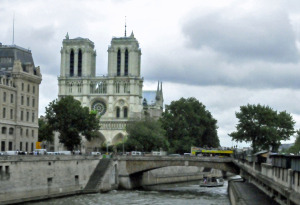In 1160 the Bishop of Paris wanted a cathedral befitting the most populous city in Europe. For the location of his new cathedral he selected the Île de la Cité, an island in the Seine, previously home to a temple to Jupiter and an early church. Pope Alexander III laid the foundation stone in 1163 and workers began constructing the east end, surrounding the altar, so Mass could be said during construction of the remaining sections. As the eastern walls designed to accommodate large altar windows rose higher, they began to flex outwardly. The solution included buttresses extending from upper points on the walls to the ground, an idea suggested by the vision of a restored Temple reported in the Book of Ezekiel but not employed previously.
When the cathedral was finally completed in 1345, it was 420 feet long and had massive twin towers, each 230 feet tall. Colorfully painted gargoyles directed rainwater away from the walls. Notre Dame’s flying buttresses, pointed arches, and rose windows became the model for subsequent French cathedrals, a style Renaissance writers pejoratively labeled “Gothic.”
During the French Revolution, opponents of the Catholic Church obliterated visible symbols of Christianity and converted Notre Dame into a “Temple of Reason.” Guiotine-inspired revolutionaries beheaded statues of Biblical kings of Judah, mistaking them for despised French kings. In 1801, Notre Dame was again usable as a church but was in a serious state of disrepair. Victor Hugo wrote The Hunchback of Notre Dame in 1830 to call attention to the value of Gothic architecture and the urgency of rescuing the cathedral. The popular novel spurred a controversial 20-year restoration that added a spire but left the famous gargoyles unpainted.
Notre Dame is the most popular attraction in Paris, welcoming twice as many visitors as the Eiffel Tower. Far fewer people visit the National Museum of the Middle Ages, where the stone heads of the cathedral’s decapitated kings, rediscovered in 1977, are on display.

Comments are closed.